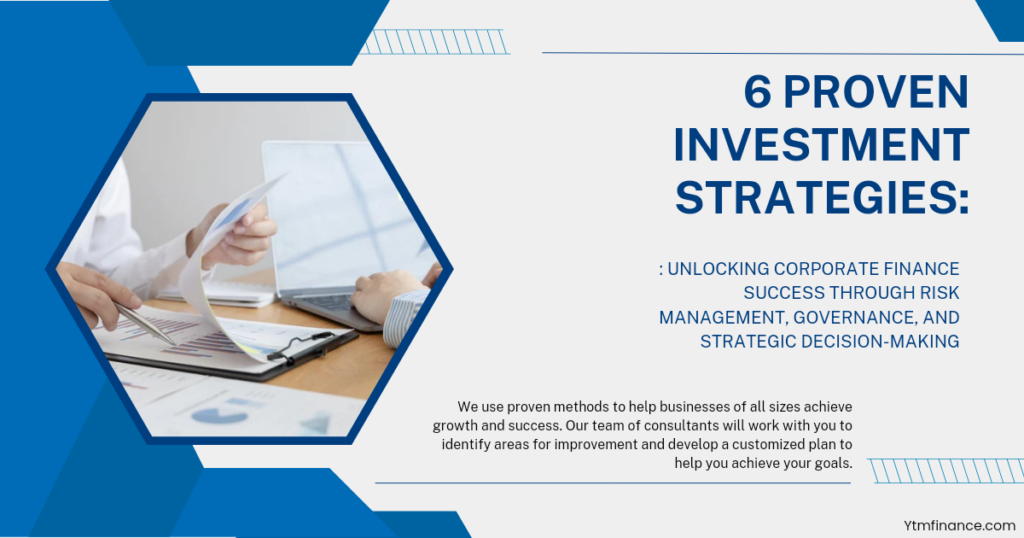6 Proven Investment Strategies: Unlocking Corporate Finance Success through Risk Management, Governance, and Strategic Decision-Making

Introduction:
Investment on corporate finance encompasses a wide range of financial activities and decisions undertaken by corporations to maximize shareholder value and achieve long-term sustainability. In this comprehensive guide, we’ll delve into the core aspects of corporate finance, including financial statement analysis, corporate valuation, capital budgeting, and strategic considerations such as financial restructuring and mergers & acquisitions. Whether you’re a seasoned finance professional or a novice entrepreneur, this guide will equip you with the knowledge and tools to navigate the complex landscape of corporate finance with confidence and insight.
1. Financial Statement Analysis: Understanding the Language of Business
1.1 Overview of Financial Statements:
Financial statements serve as the primary source of information for investors, creditors, and other stakeholders to assess a company’s financial health and performance. The three main financial statements include the income statement, balance sheet, and cash flow statement, each providing unique insights into different aspects of a company’s operations and finances.
1.2 Key Financial Ratios and Metrics:
Financial ratios and metrics play a crucial role in analyzing financial statements and evaluating a company’s financial performance and solvency. Commonly used ratios include liquidity ratios, profitability ratios, leverage ratios, and efficiency ratios, each offering valuable insights into various aspects of a company’s operations and financial position.
1.3 Interpretation of Financial Statements:
Interpreting financial statements requires a deep understanding of accounting principles, industry dynamics, and economic factors. Analysts examine trends over time, compare performance against industry benchmarks and peers, and assess the quality of earnings and cash flows to form a comprehensive view of a company’s financial standing and prospects.
2. Corporate Valuation Methods: Unlocking the Intrinsic Value
2.1 Overview of Corporate Valuation:
Corporate valuation is the process of determining the intrinsic value of a company’s stock or business assets. Valuation methods vary depending on the nature of the business, industry dynamics, and the purpose of the valuation, whether it’s for investment analysis, financial reporting, or mergers & acquisitions.
2.2 Common Valuation Approaches:
Several valuation approaches are commonly used by analysts, including discounted cash flow (DCF) analysis, comparable company analysis (CCA), precedent transactions analysis, and asset-based valuation methods. Each approach has its strengths and limitations, and analysts often use a combination of methods to triangulate the fair value of a company.
2.3 Factors Influencing Valuation:
Corporate valuation is influenced by a multitude of factors, including the company’s financial performance, growth prospects, risk profile, competitive position, industry dynamics, and macroeconomic trends. Analysts must carefully consider these factors and make appropriate adjustments to their valuation models to arrive at a realistic and reliable estimate of value.
3. Capital Budgeting and Investment Decisions: Deploying Capital Wisely
3.1 Capital Budgeting Process:
Capital budgeting involves evaluating and selecting investment projects that generate positive returns and create long-term value for the company. The capital budgeting process typically involves identifying investment opportunities, estimating cash flows, assessing risk, and applying appropriate investment criteria to prioritize projects.
3.2 Investment Appraisal Techniques:
Various investment appraisal techniques are used to evaluate investment projects, including net present value (NPV), internal rate of return (IRR), payback period, and profitability index. These techniques help analysts assess the economic viability of projects and determine whether they meet the company’s investment objectives and hurdle rates.
3.3 Risk Management in Capital Budgeting:
Effective risk management is critical in capital budgeting to mitigate uncertainties and ensure the success of investment projects. Analysts must identify, assess, and quantify risks associated with each investment opportunity, considering factors such as market risk, operational risk, regulatory risk, and project-specific risks.
4. Financial Restructuring and Mergers & Acquisitions: Navigating Strategic Transitions
4.1 Financial Restructuring Strategies:
Financial restructuring involves making significant changes to a company’s capital structure, operations, or ownership to improve financial performance and enhance shareholder value. Common restructuring strategies include debt restructuring, equity recapitalization, asset divestitures, and corporate reorganizations.
4.2 Mergers & Acquisitions (M&A):
Mergers and acquisitions are strategic transactions that involve combining two or more companies to achieve synergies, expand market presence, or diversify business operations. The M&A process encompasses various stages, including deal sourcing, due diligence, valuation, negotiation, and integration planning, each requiring careful analysis and execution.
4.3 Integration and Post-Merger Integration (PMI):
Successful integration is critical to realizing the full value of M&A transactions. Post-merger integration involves integrating people, processes, systems, and cultures to achieve synergies, optimize operations, and minimize disruption. Effective PMI requires meticulous planning, clear communication, and strong leadership to navigate challenges and ensure a smooth transition.

5. Financial Risk Management: Safeguarding Against Uncertainty
5.1 Understanding Financial Risks:
Financial risk management involves identifying, assessing, and mitigating risks that could adversely impact a company’s financial health and performance. Market risk arises from fluctuations in interest rates, exchange rates, and asset prices, while credit risk pertains to the potential for borrowers to default on their obligations. Operational risk encompasses risks related to internal processes, systems, and human error. By understanding these risks and their potential impact, businesses can develop robust risk management strategies to protect their bottom line.
5.2 Risk Management Strategies:
Effective risk management involves deploying a range of strategies to mitigate financial risks. Hedging involves using financial instruments, such as futures contracts or options, to offset the impact of adverse price movements. Diversification spreads risk across different assets or investments to reduce exposure to any single risk factor. Insurance provides protection against specific risks, such as property damage or liability claims. By implementing a combination of these strategies, businesses can build resilience and adaptability in the face of uncertainty.
5.3 Role of Derivatives:
Derivatives are financial instruments whose value is derived from an underlying asset, index, or rate. They can be used to hedge against price fluctuations, speculate on future market movements, or manage risk exposure. For example, a company may use futures contracts to lock in a future price for raw materials to protect against price volatility. Options can provide insurance against adverse price movements while allowing for potential upside gains. Swaps allow companies to exchange cash flows to manage interest rate or currency risks. However, derivatives also carry risks, including counterparty risk and market volatility, so careful consideration and risk management are essential when using these instruments.
5.4 Case Studies:
Examining real-world case studies provides valuable insights into effective risk management practices and the consequences of inadequate risk management. For example, the 2008 financial crisis highlighted the risks associated with complex financial products and lax risk management practices in the banking sector. On the other hand, companies that successfully navigate crises often have robust risk management frameworks in place. Case studies can illustrate the importance of proactive risk identification, scenario planning, stress testing, and contingency planning in mitigating financial risks and preserving shareholder value.
6. Corporate Governance: Enhancing Transparency and Accountability
6.1 Principles of Good Governance:
Good corporate governance is essential for maintaining the trust of investors, customers, employees, and other stakeholders. Transparency ensures that stakeholders have access to accurate and timely information about the company’s performance, financial position, and governance practices. Accountability holds corporate leaders accountable for their actions and decisions, ensuring that they act in the best interests of shareholders and stakeholders. Fairness ensures that all stakeholders are treated equitably and that conflicts of interest are managed effectively.
6.2 Board of Directors’ Roles:
The board of directors plays a critical role in overseeing corporate governance and guiding the strategic direction of the company. The board is responsible for appointing senior management, setting corporate objectives and policies, and overseeing risk management and compliance efforts. Individual directors are expected to act with due care, diligence, and loyalty, exercising independent judgment and avoiding conflicts of interest. Committees, such as audit, compensation, and nominating committees, assist the board in fulfilling its responsibilities and ensuring effective governance practices.
6.3 Ethical Conduct:
Ethical conduct is a cornerstone of good corporate governance and involves adhering to high standards of honesty, integrity, and fairness in all business dealings. Companies with strong ethical cultures are more likely to attract and retain customers, employees, and investors and are better positioned to weather reputational crises. Ethical conduct encompasses a range of issues, including fair treatment of employees, responsible environmental stewardship, and ethical marketing and sales practices. Corporate leaders must lead by example and foster a culture of integrity and accountability throughout the organization.
6.4 Regulatory Developments:
Regulatory frameworks play a crucial role in shaping corporate governance practices and ensuring compliance with legal and ethical standards. Regulatory bodies, such as the Securities and Exchange Commission (SEC) in the United States or the Financial Conduct Authority (FCA) in the United Kingdom, establish rules and standards for financial reporting, disclosure, and shareholder rights. Corporate governance codes, such as the Sarbanes-Oxley Act or the UK Corporate Governance Code, provide guidelines for best practices in corporate governance. Companies must stay abreast of regulatory developments and implement appropriate policies and procedures to comply with evolving legal and regulatory requirements.
Conclusion: Empowering Financial Excellence:-
Corporate finance is a multifaceted discipline that requires a deep understanding of financial principles, strategic acumen, and analytical rigor. By mastering the fundamentals of financial statement analysis, corporate valuation, capital budgeting, and strategic financial management, companies can make informed decisions, allocate resources effectively, and create sustainable value for shareholders and stakeholders. As you embark on your journey in corporate finance, remember to embrace continuous learning, adapt to changing market dynamics, and leverage your knowledge and skills.
FAQ :-
- What is investment decision-making in corporate finance?
- Investment decision-making in corporate finance involves evaluating and selecting the most profitable or strategically suitable projects or assets to invest in. This process is crucial for driving growth and ensuring the efficient allocation of capital resources.
- How are investment decisions evaluated in corporate finance?
- Investment decisions are typically evaluated using various financial tools and metrics such as Net Present Value (NPV), Internal Rate of Return (IRR), payback period, and Economic Value Added (EVA). These tools help determine the potential returns and risks associated with an investment.
- What role do capital markets play in corporate finance investment?
- Capital markets are vital for corporate finance as they provide a platform for companies to raise funds through the issuance of stocks, bonds, and other financial instruments. This capital is essential for funding new projects, expansions, or restructuring operations.
- What is the difference between capital budgeting and investment management?
- Capital budgeting is the process of analyzing and planning expenditures on assets whose returns will be realized beyond a year. In contrast, investment management typically involves handling various securities (stocks, bonds, etc.) and other assets to meet specified investment goals for the benefit of investors.
- How do strategic investments differ from tactical investments in corporate finance?
- Strategic investments are long-term investments made with a focus on achieving broader business objectives such as entering a new market or developing new capabilities. Tactical investments are more short-term and focus on achieving immediate financial returns or advantages.
- Can corporate finance principles be applied to personal investment strategies?
- Yes, many principles of corporate finance, such as risk management, asset diversification, and valuation, can be applied to personal investment strategies to help individuals make more informed financial decisions.
- What are some common challenges in making investment decisions in corporate finance?
- Common challenges include predicting future market conditions, assessing the true value of potential investments, managing investment risks, and aligning investment choices with the overall strategic goals of the company.
- How do companies assess the risk associated with an investment?
- Companies assess investment risk by analyzing market trends, economic indicators, political stability, and specific factors related to the investment. Techniques like sensitivity analysis, scenario analysis, and Monte Carlo simulations are often used to model and predict risk scenarios.
Read More:- Asset Allocation, Diversification, and Risk Management: 3 Strategies for Maximizing Portfolio Resilience.





